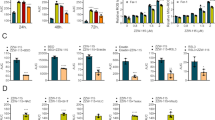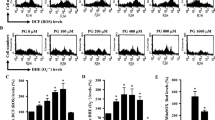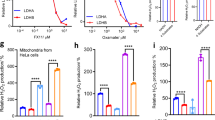Abstract
Previously we showed that tirapazamine (SR 4233, Win 59075) is cytotoxic towards hepatocytes under conditions of hypoxia but not in 10% or 95% oxygen and that bioreduction by DT-diaphorase or cytochrome P450 is not a major pathway. In the present study, we report that tirapazamine is highly cytotoxic to isolated rat hepatocytes maintained under 1% oxygen and the molecular cytotoxic mechanism has been elucidated. Cytotoxicity was prevented by the cytochrome P450 2E1 inhibitors phenyl imidazole, isoniazid, isopropanol or ethanol, suggesting that cytochrome P450 2E1 catalysed tirapazamine reductive bioactivation. By contrast, dicoumarol, a DT-diaphorase inhibitor, markedly increased tirapazamine-induced cytotoxicity. Cytotoxicity was also inhibited in normal but not DT-diaphorase-inactivated hepatocytes by increasing cellular NADH levels with lactate or ethanol or the mitochondrial respiratory inhibitors. Evidence that oxygen activation contributed to cytotoxicity was that glutathione oxidation occurred well before cytotoxicity ensued and that tirapazamine was more cytotoxic towards catalase- or glutathione reductase-inactivated hepatocytes. Furthermore, polyphenolic antioxidants such as quercetin, caffeic acid or purpurogallin, the radical trap Tempol or the iron chelator desferrioxamine prevented tirapazamine-mediated cytotoxicity. However, the antioxidants diphenylphenylenediamine, butylated hydroxyanisole or butylated hydroxytoluene did not prevent cytotoxicity and malonaldehyde formation was not increased, suggesting that lipid peroxidation was not important. The above results suggest that DT-diaphorase detoxifies tirapazamine whereas reduced cytochrome P450 reduces tirapazamine to a nitrogen oxide anion radical which forms cytotoxic reactive oxygen species as a result of redox cycling.
This is a preview of subscription content, access via your institution
Access options
Subscribe to this journal
Receive 24 print issues and online access
$259.00 per year
only $10.79 per issue
Buy this article
- Purchase on Springer Link
- Instant access to full article PDF
Prices may be subject to local taxes which are calculated during checkout
Similar content being viewed by others
Author information
Authors and Affiliations
Rights and permissions
About this article
Cite this article
Khan, S., O'Brien, P. Molecular mechanisms of tirapazamine (SR 4233, Win 59075)-induced hepatocyte toxicity under low oxygen concentrations. Br J Cancer 71, 780–785 (1995). https://doi.org/10.1038/bjc.1995.151
Issue Date:
DOI: https://doi.org/10.1038/bjc.1995.151



